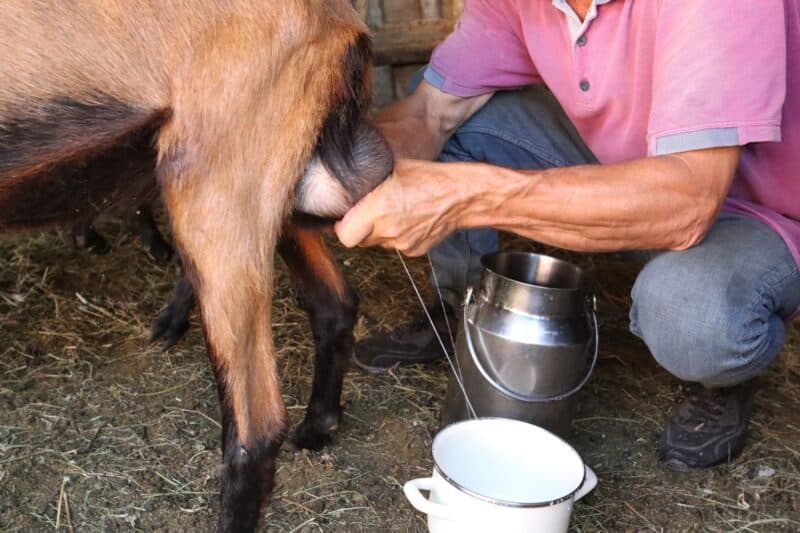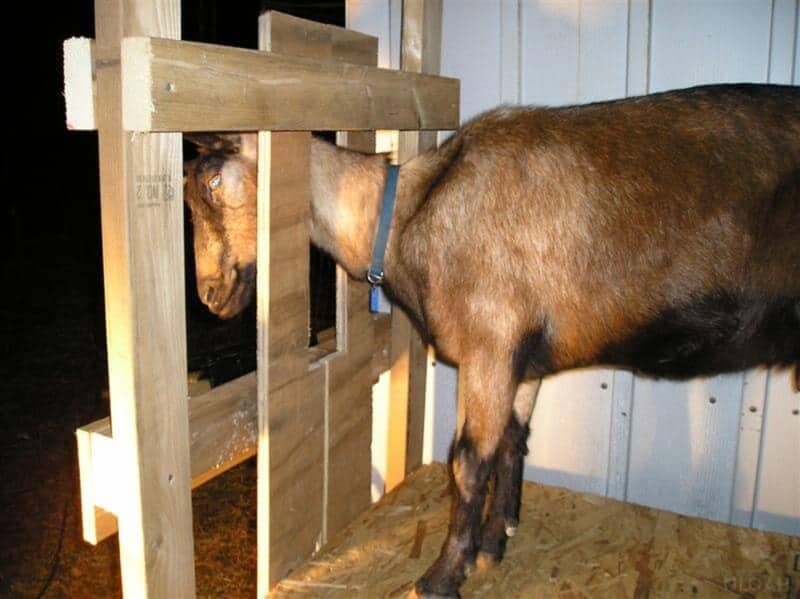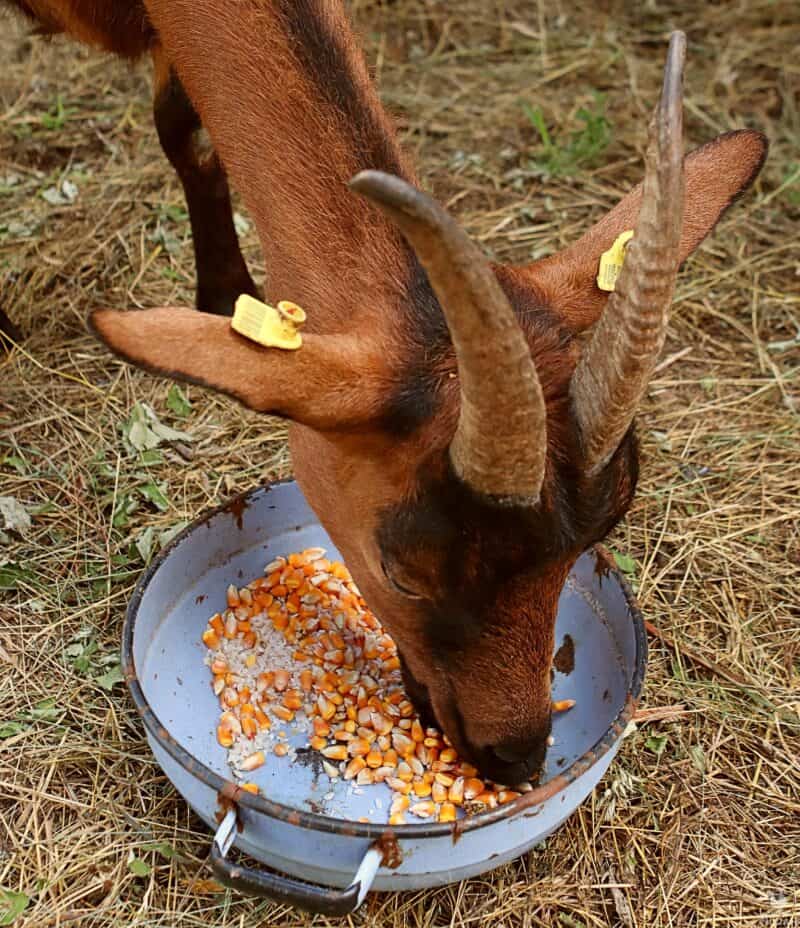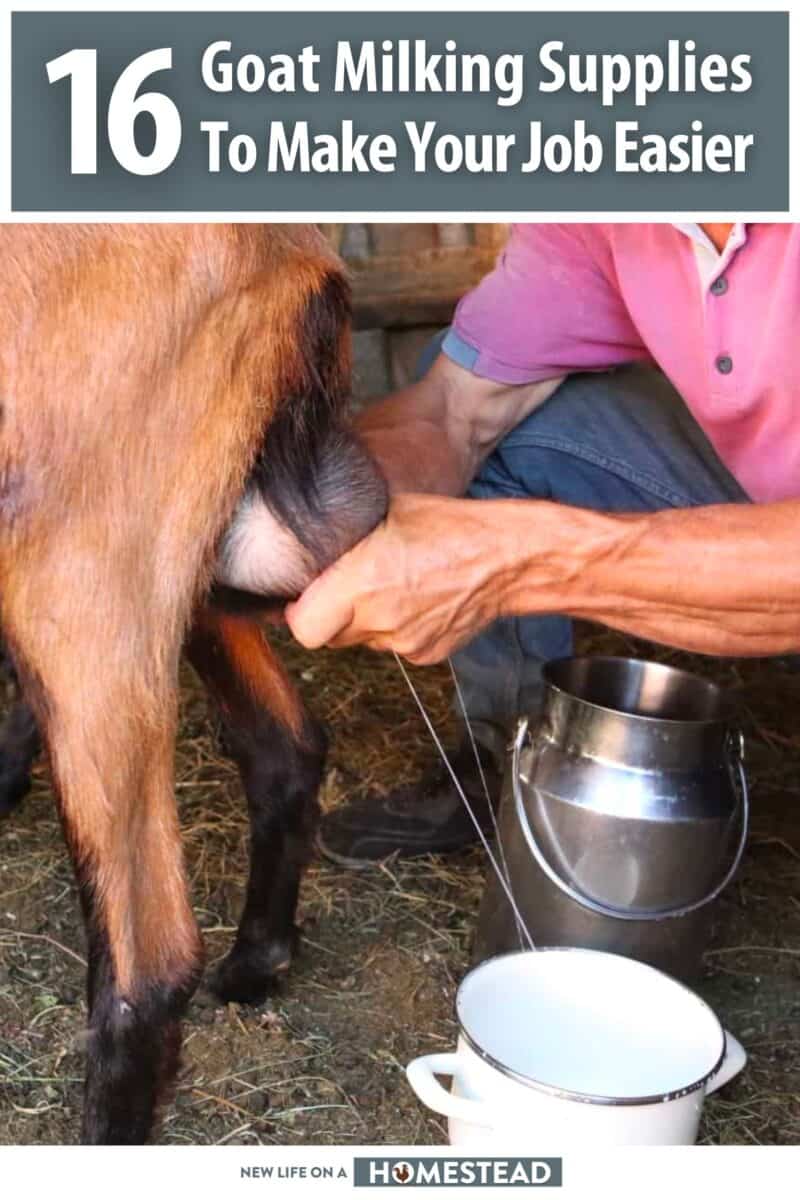If you keep dairy goats, you already know that milking is an essential task. But for many goat-owning homesteaders, providing a sustainable source of fresh, nutritious milk for consumption is quite a chore!

Goats are rarely cooperative, and milking is a surprisingly tricky skill. But, with the right gear and supplies on hand, you can make this aggravating chore so much easier…
In this article, I’ll tell you about 16 must-have goat milking supplies that can make the process more efficient, and even more enjoyable- for both you and your goats!
From milking stands and stanchions to bowls and strainers, these items will help you streamline your milking routine.
1. Milking Stand
A milking stand is one of the most fundamental pieces of equipment for anyone who regularly milks goats.
It elevates the goat off the ground, making the milking process much more comfortable for both the animal and the person doing the milking.
The stand typically consists of a raised platform with a ramp for the goat to walk up, and a secure area for the goat to stand during milking.

This not only improves the overall efficiency of the milking process but also reduces the risk of injury to the goat or the person milking – stooping over, squatting and kneeling all day will take their toll, ask me how I know!
Additionally, some milking stands come with adjustable height settings, allowing for greater customization and ease of use in any environment or for special needs.
These can be easily built yourself if you are handy, or purchased with any number of options. Be warned! They can be very spendy!
2. Milking Shed
A milking shed might sound like a luxury- who has a shed dedicated for milking goats?!- but it’s actually totally practical.
A milking shed provides a dedicated space for milking goats, offering protection from rain, harsh weather conditions, and fluctuating temperatures.
This ensures that both the goat and the person milking can stay warm and dry, or just more comfortable, throughout the process.
A well-designed milking shed should have proper ventilation, lighting, and drainage systems in place, creating a clean and hygienic environment for milking.
Moreover, having a dedicated space for milking can help streamline the process and improve overall efficiency since goats will quickly associate it with treats. More on that in a second!
It may also include convenient storage areas for milking supplies and equipment, making it easier to keep everything organized and accessible.
These can be as simple or elaborate as you want, and even a corral with a sturdy canvas roof might be adequate!
3. Stanchion
A stanchion is indispensable: this is the piece of goat milking equipment that holds the goat’s head still and thus keeps the animal securely in place during milking.
By preventing the goat from moving around excessively, a stanchion helps ensure a smooth and efficient milking process, and minimizes the risk of spills or injuries.
Do watch out for kicks; some goats seem to delight in kicking over your bowl when it is full.
Most stanchions are adjustable, allowing them to accommodate goats of various heights, sizes and breeds, with or without horns.
They also usually feature a feed trough or bucket attachment for the next item on our list so the goat can eat while being milked. This also helps keep them calm and relaxed!
More than most items on this list, it is the stanchion that makes the milking process more manageable; unrestrained goats are a nightmare to milk…

4. Food Bucket
A food bucket, or treat bucket is another truly vital accessory for keeping goats occupied and calm during the milking process.
Goats are highly food motivated, like most animals. Arguably, that’s the only thing that motivated them!
Providing the goat with its favorite tasty treat while it is being milked will help reduce stress, and ensure a smoother turn on the table.
Food buckets come in various sizes and designs, with some featuring clips or hooks to attach them securely to stanchions or milking stands.
You don’t need a purpose-designed bucket for the purpose, though; it is possible to use any other repurposed container so long as it is stable and the goat can reach it and can’t knock it over.
5. Milking Machine
For those looking to automate the goat milking process, investing in a milking machine can be a game-changer.
While these machines are expensive, they offer significant time and labor savings, making them an ideal choice for larger herds or busy farmers.
Milking machines work by attaching suction cups to the goat’s teats, which gently extract the milk and help ensure the animal’s comfort.
The milk is then collected in a closed system into a sanitary container, reducing the risk of contamination overall significantly.
These machines are typically designed to accommodate multiple goats at once, at least two and sometimes four or more, further increasing your efficiency.
By automating the milking process, you can save more time to focus on other tasks and get your goats off the table quicker. That means happier goats and a happier you!
6. Clippers
Clippers? What are clippers doing on a list of milking tools? Well, let me tell ye! Clippers play a crucial role in a sanitary milking environment.
Regularly trimming the hair on and around the goat’s backside, udder and teats helps prevent the milk from becoming contaminated with dirt, debris, or bacteria in a way that other methods just can’t.
Plus, smooth skin is much easier to disinfect compared to a mass of hair matted with mud, pee and poop. This saves time and aggravation before you get down to milking, too.
Clippers come in various sizes and styles, so choose the one that best suits your needs and preferences.
A well-groomed goat not only ensures cleaner milk but also promotes better overall hygiene for the animal. I cannot recommend the practice enough!
7. Brush
A brush is a simple tool for maintaining cleanliness and hygiene.
By brushing off grass, dirt, and other debris from the goat’s udder and surrounding areas before milking, you’ll once again reduce the risk of milk contamination, specifically by stuff falling into your milk bowl.
There’s no end to the kinds of brushes out there, so simply choose one that best suits your needs and preferences.
8. Udder Wash
Udder wash is another link in the pre-milking chain of hygiene.
This specially formulated solution is designed to sanitize the goat’s udder and teats before milking, helping to prevent the spread of germs and bacteria on the goat and also in your milk.
This routine, more than most, ensures that the milk you collect is as clean as possible. And don’t worry about hitting the goat with harsh cleaners.
Most udder washes are gentle on the skin and easy to apply, making them suitable for regular use each and every time.
You can purchase this stuff by the gallon, or make your own from proven, time-tested recipes.
9. Washcloths
Washcloths or wipes are used together with udder wash to gently clean and sanitize the goat’s udder and teats before milking.
Washcloths come in various materials, sizes, and textures, allowing you to select the most suitable option for your needs but whichever one you pick avoid any type that is likely to retain little bits of debris.
And keep plenty on hand, using a new, clean cloth for each goat! Cross-contamination is a thing, people.
Some keepers may prefer disposable wipes for added convenience and hygiene at the cost of, well, increased and ongoing cost.
10. Strip Cup
A strip cup is nothing more than an easily rinsed cup or other container used to catch the first couple of squirts of milk you collect from your goats. Why do this?
The first squirts of milk often have the highest concentration of bacteria, which is why it’s essential to collect and discard them before collecting milk for consumption!
A strip cup provides a dedicated container for catching these initial squirts, allowing you to easily dispose of them.
Whatever kind of container you use, make sure it is distinct enough that you do not use it for any other purpose! Again, cross-contamination.

11. Steel Milking Bowl or Bucket
When it comes to collecting milk, classic is best: a steel milking bowl or bucket offers several advantages over plastic or glass alternatives.
Steel is more sanitary than plastic, as it is less likely to harbor bacteria and is easier to clean thoroughly.
Additionally, steel is much safer than glass in the sometimes-rambunctious operation of milking, as it won’t shatter or break if accidentally dropped or kicked by an ornery goat.
Steel milking containers are commonly available, and some feature built-in handles or lids for added convenience.
By opting for a steel milking bucket in lieu of other kinds, you can ensure that the milk you collect remains as pure as possible.
12. Reusable Ice Packs
Reusable ice packs are my secret trick for keeping the freshness and quality of my collected milk.
You ever tried fresh goat milk? Notice how it tastes sharp? A little odd. That isn’t totally natural; it happens because the milk was allowed to stay warm too long.
By keeping the milk and milking bucket cold, these ice packs help prevent the growth of bacteria and the development of unpleasant odors or flavors, often referred to as “funkiness”.
Reusable ice packs can be flexible or hard, so pick a variety that is food safe and fits your milking bucket and otherwise meets your needs.
Simply keep the ice packs frozen until you need them, and then place them in and under the bucket during milking to keep the milk at an optimal temperature.
Once you’re done, wash them as instructed and re-freeze. You and your family (or customers) will notice the difference, believe me!
13. Teat Dip
Teat dip is yet another special and essential solution, but this one is designed for post-milking use to protect goat teats from infection and promote overall udder health.
After milking, the teats must be dipped in this specially formulated solution to close the opening and create a protective barrier against bacteria.
Using a teat dip as part of your milking routine is a must as it helps ensure the well-being of your goats. Skip this step at your peril!
14. Dip Cup
This one is a no-brainer: the dip cup is a dedicated container used for holding teat dip during the aforementioned post-milking sanitization process.
But listen to me: It’s absolutely mandatory that your dip cups are not the same as a strip cup, and cannot be confused for it.
Putting a teat dip in a strip cup will only lead to you dipping a wash laden with bacteria on a vulnerable teat, greatly increasing the chances of infection! The poor thing!
Keep these cups distinct and separate, and practice your workflow a few times so you don’t mess this up.
15. Strainer
A strainer is used to help assure the purity of the milk you collect from your goats.
By straining your milk before storage, you can catch any debris, hair, or other contaminants that may have found their way into the milk during the milking process.
No matter how hard you try and how much care you pour into keeping your goats clean and tidy, there will almost always be something in there!
Strainers often feature fine mesh or replaceable cloth filters to effectively remove the smallest of unwanted particles, and either should be cleaned or replaced regularly as needed.
Using a strainer religiously as part of your post-milking routine will help guarantee that your milk you worked so hard for is clean, fresh, and safe for consumption.
16. Milk Bottles
Last, and certainly not least, you will need milk bottles! Milk bottles provide a convenient and hygienic solution for storing your collected and strained goat milk.
These come in various sizes, shapes, and materials, including glass, plastic, and stainless steel, and plenty of folks just use mason jars of various sizes for the task rather than investing in special (and expensive) goat milk bottles.
But when picking your bottles, choose ones that are easy to clean and sanitize since they are intended for reuse, and also pick ones that seal tightly to maintain freshness and prevent contamination.
It’s easy for things to go wrong at the finish line if you choose inadequate bottles, and especially if you want a long shelf-life for your milk you need bottles that can go the distance!

Tom has lived and worked on farms and homesteads from the Carolinas to Kentucky and beyond. He is passionate about helping people prepare for tough times by embracing lifestyles of self-sufficiency.
